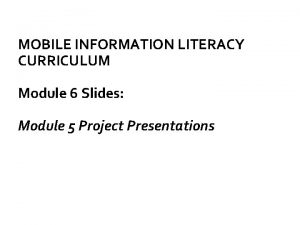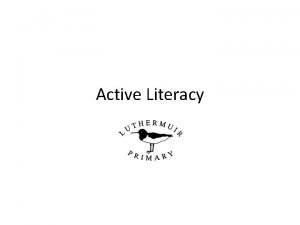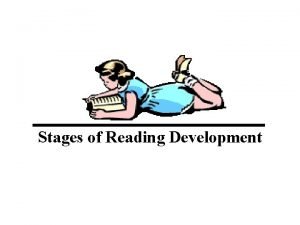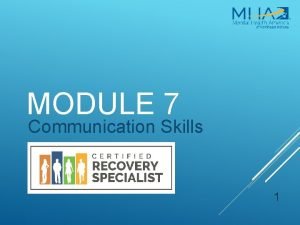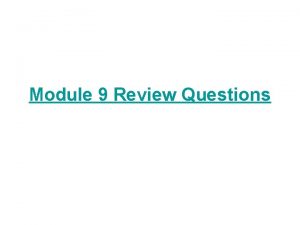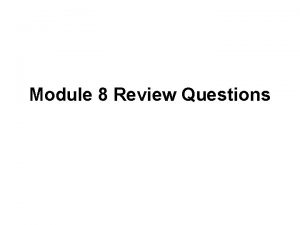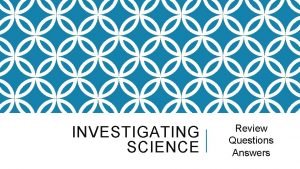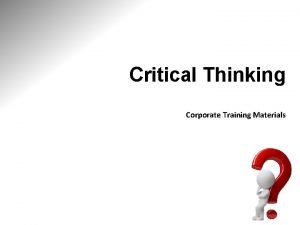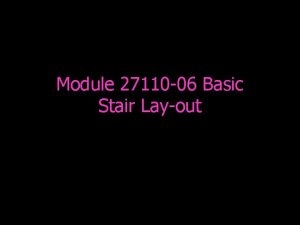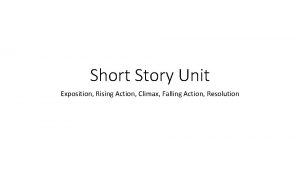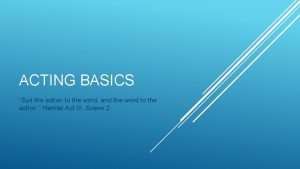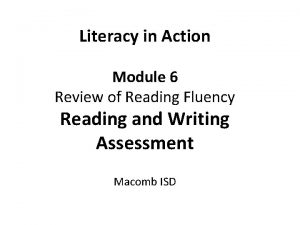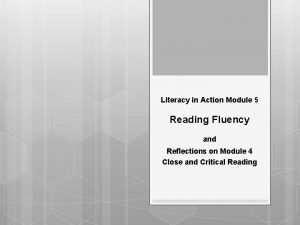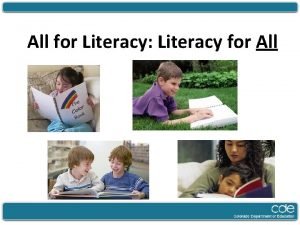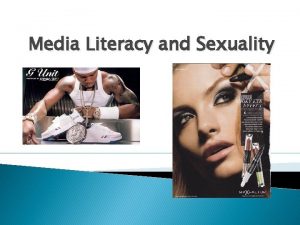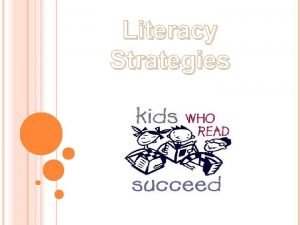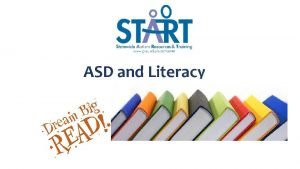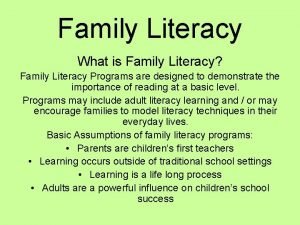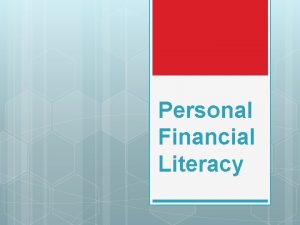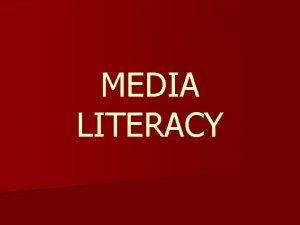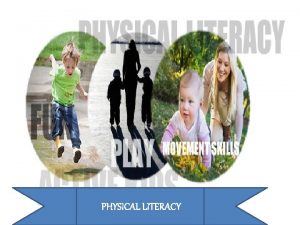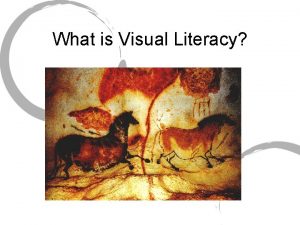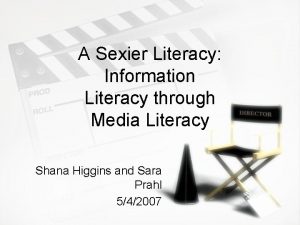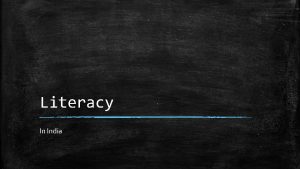Literacy in Action Module 6 Review of Reading





















- Slides: 21

Literacy in Action Module 6 Review of Reading Fluency Reading and Writing Assessment Macomb ISD

Review of Reading Fluency • Share the following: How many students used the reading fluency system? How many readings did the students complete? What activities did you use? Describe the students’ progress? How will you continue this work?

Goals for this Module Participants will • Review the Comprehensive Literacy Plan www. missionliteracy. com • Use this model to develop a Classroom/School Literacy Plan and the Student Literacy Profile they will use to individualize literacy development. • Learn how to develop Writing from Reading Assessments that measure ability to integrate and evaluate multiple media; delineate and evaluate argument; and analyze texts for themes, topics and development with argumentative and informative/explanatory essays.

What do you know about your students’ literacy skills? At what level do they read? How fluent is their writing and reading? How well do they comprehend text? Can they analyze text for craft, perspective, point of view or bias? • Can they read closely and critically? • Can they read and write argument? • •

What plans do you have for your students’ literacy skill development? • Do you know what they need? • Do you know where to begin in the development process? • Do you have a system for monitoring their literacy development progress? • Do your students have a system for knowing their own literacy progress?

Middle and High School Student Literacy Profile Name_______________________ Fall Grade_______ Winter Spring Reading Fluency Grade___ Rubric__ Grade__ Rubric___ Grade___ Rubric___ Reading Grade Level ACT Reading Score Close and Critical #1 Close and Critical #2 Close and Critical #3 Close and Critical #4 Profundity Score Identify Argument Writing Fluency Argument Informative/Explanatory Grade ______ Score ____of 40 Rubric Score ___/3 Score ____of 15 Score _____of 4 Grade ______ Score ____of 40 Rubric Score ___/3 Rubric Score ___/3 Score ____of 15 Score ____of 4 # of words _____ Rubric Score ___/4 # of words_____ Rubric Score ___/4 Narrative (Grade 6 -8) Rubric Score ___/4 ACT Persuasive Writing Handwriting Speed and Legibility Language Oral Language ACT Rubric ___/6 # of letter____ Rubric Score ____/5 ACT Rubric ___/6 # of letters Rubric Score ___/5 Rubric Score __/4 Rubric Score___/4 # of words ____ Stage _______ # of words____ Stage_______ # correct ____of 15 # correct____ of 15 Word Study Vocabulary Spelling Grammar and Word Usage ACT English Test Preparation North Dakota State University

Your turn… With your table partners, discuss the Student Literacy Profile. • Which items will you include for your students’ profiles? • Which items would you consider adding? • Which literacy skills do your students monitor, but are not included on the list?

Sample Literacy Plan – School ABC Literacy Initiative Plan AMENDED Initiative Department(s) Writing Tracker -Science Persuasive Writing -Social Studies -Mathematics English ACT /MME Initiative Math Guided Highlighting ELA Guided Highlighted reading for Science Items on the ACT Science Assessment MME Social Studies Geography Social Studies and World History -Art Close and Critical -Performing Arts Reading -Foreign Language Work Keys -PE/Health Career Education Overview Timeline Point Person(s) Responsible Goals Writing tracker to develop fluency Students will: -Write fluently in Math -Track the number of words and domain specific language -Write a certain number of writes per semester (as decided by department -Complete a reflection sheet on writing per semester Intensive focus/mastery level instruction to revise essays according to the ACT writing rubric up to a 4 December – ACT math assessment 30 promising students will receive intensive mastery level teaching/learning episodes in Cabin and designated class. Analyze Test results for personalize teaching * They will be retested at the end of January Students will: -9 th, 10 th , 11 th Grades: Complete two of each genres (prose fiction, natural science, social science, humanities) per year ACT preparation: 11 th Grade students receive 5 of each of the four genres with GHR before March Guided Highlighted Reading for the items on the ACT Science Assessment ***(Should we assess the students on the Science part of the test to determine specific needs? ? ? ? ) Review Tracker writings Sept: Set up folders Reflection at the end of semester March: Set up folders Retest with prompt at the end of January and continued to March 5 Chairs of Social Studies, Science Mathematics Departments Teacher Develop fluency skills Up to 150 wp five minutes HS and 125 MS Promising students writing minimally a “ 4” essay Now until March 5 Teacher Prepare at least 20 students for the challenges of the ACT mathematics assessment Intensive focused /mastery teaching and learning Students will: -Use the CCR Protocol to analyze content specific items (i. e. articles, songs, paintings) -Write out answers using the protocol or discuss the answers to the protocol questions using a Socratic method -Complete a reflection sheet Mastery level focused teaching/learning on Work Keys Next 5 weeks the 11 th students will receive an intensive course in Geography and World History -Teachers will receive training on the four CCR questions, see examples of how to use the protocol, and see the connections to the CCSS. -Teachers will complete three CCR protocols throughout each course. Teachers will turn in student samples of each CCR. Sept: Grade 11 students assessed on Committee the ACT-like reading portion of the Science Chair assessment Feb: Grade 11 re-assessed on reading portion of the ACT-like test Sept: Teachers select the passages they will use for each of the grade levels As it is appropriate to prepare students for ACT Science Teacher Chairs of the electives and encore subjects School Improvement Chair Develop Reading fluency and build reading stamina to prepare for the ACT reading assessment Prepare Promising students for the ACT Science Assessment Prepare promising students for Social Studies portion of the MME Develop Close and Critical Reading/Thinking/Writing Skills Meet CCSS Reading Standards # 1 – 9 Goal? ?

Your turn… With table partners review the Literacy Plan… In what areas do you have data on your students? Are there areas where you do not have data for your students? What are some areas where you would consider collecting data?

Guided tour of the Comprehensive Literacy on www. missionliteracy. com • Learn about the resources to establish a plan/profile for your students’ literacy development: at the level of student, classroom, grade level, school, district, county or state. • Find out how to locate and use the assessments • See samples of the plans/profiles to determine how they can be modified for your needs.

Independent Exploration of the Comprehensive Literacy Plan Assessments and Strategies Participants will begin to develop their own literacy plans and student profiles. They will have twenty minutes for exploration on their own.

Performance Tasks that have students writing in response to two or more texts The Performance Tasks meet the CCSS Reading Anchor Standards that follow. Integration of Knowledge and Ideas 7. Integrate and evaluate content presented in diverse media and formats, including visually and quantitatively, as well as in words. 8. Delineate and evaluate the argument and specific claims in a text, including the validity of the reasoning as well as the relevance and sufficiency of the evidence. 9. Analyze how two or more texts address similar themes or topics in order to build knowledge or to compare the approaches the authors take.

The Performance Tasks meet the CCSS Writing Anchor Standards that follow. Text Types and Purposes 1. Write arguments to support claims in an analysis of substantive topics or texts, using valid reasoning and relevant and sufficient evidence. 2. Write informative/explanatory texts to examine and convey complex ideas and information clearly and accurately through the effective selection, organization, and analysis of content. Production and Distribution of Writing 4. Produce clear and coherent writing in which the development, organization, and style are appropriate to task, purpose, and audience.

A “Snapshot” of the Cognitive Rigor Matrix (Hess, Carlock, Jones, & Walkup, 2009) Depth of Thinking (Webb) + Type of Thinking (Revised Bloom, 2001) DOK Level 1 DOK Level 2 Recall & Reproduction Basic Skills & Concepts DOK Level 3 Strategic Thinking & Reasoning DOK Level 4 Extended Thinking - Explain how concepts or ideas specifically relate to other content domains or concepts Remember - Recall, locate basic facts, definitions, details, events Understand - Select appropriate words for use when intended meaning is clearly evident - Specify, explain relationships - summarize – identify central ideas - Explain, generalize, or connect ideas using supporting evidence (quote, text evidence, example…) Apply - Use language structure (pre/suffix) or word relationships (synonym/antonym) to determine meaning – Use context to identify word meanings - Obtain and interpret information using text features - Devise an approach - Use concepts to solve non among many alternatives to -routine problems research a novel problem - Identify the kind of information contained in a graphic, table, visual, etc. – Compare literary elements, facts, terms, events – Analyze format, organization, & text structures - Analyze or interpret author’s craft (e. g. , literary devices, viewpoint, or potential bias) to critique a text – Analyze multiple sources or texts - Analyze complex/ abstract themes – Cite evidence and develop a logical argument for conjectures based on one text or problem - Evaluate relevancy, accuracy, & completeness of information across texts/ sources -Develop a complex model for a given situation -Develop an alternative solution -Synthesize information across multiple sources or texts -Articulate a new voice, alternate theme, new knowledge or perspective Analyze Evaluate Create - Brainstorm ideas, concepts, problems, or perspectives related to a topic or concept -Generate conjectures or hypotheses based on observations or prior knowledge and experience

Middle and High School Student “Writing about Reading” Assessment Profile Name_________________ Grade_______ Writing in Response to Reading Read for argument elements and write and argumentative essay Evaluate DOK # 4 CCSS Reading Standard # 8 CCSS Writing Standard # 1 Read/View/Listen to integrate and evaluate and write informative/explanatory essay Evaluate DOK # 4 Analyze DOK #4 CCSS Reading Standard # 7 CCSS Writing Standard # 2 Analyze two or more texts for development of themes or topics or the approaches taken. Write a constructed response or an informative/explanatory essay Analyze DOK # 4 CCSS Reading Standard # 9 CCSS Writing Standard # 2 Close and Critical #1 CCSS Reading Standards 1, 2, 3 Understand DOK # 2 Close and Critical #2 CCSS Reading Standards 4, 5, 6 Analyze DOK # 3 Close and Critical #3 CCSS Reading Standards 7, 8, 9 Understand DOK # 3 Fall Winter Spring Grade ___ Rubric___ Grade ___ Rubric Grade ___ Rubric ___ Grade ___ Rubric Score ___/3 Rubric Score ___/3 Rubric Score ___/3

Writing about Reading Assessments CCSS Reading Standard # 7: Integrate and evaluate content presented in diverse media and formats, including visually and quantitatively, as well as in words. CCSS Writing Standard #2: Write informative/explanatory texts to examine and convey complex ideas and information clearly and accurately through the effective selection, organization, and analysis of content. Grades 7 - 9 Directions: You will read two passages, The Rise of the Robot Pet by Elena Soto and Love In the Time of Robots by Frank Mullin, and view three videos, taking notes on these sources. Your Assignment: Your class is writing articles for the school newspaper on robotic pets. Write an informational essay sharing what you have learned from your research on robotic pets (the two articles and three videos), and also explain how the different media provided the information. How your essay will be scored: Your essay will be scored using the SBAC 4 -point Informative-Explanatory (Grades 6 -11) Writing Rubric

Writing about Reading Assessments CCSS Reading Standard # 8: Delineate and evaluate the argument and specific claims in a text, including the validity of the reasoning as well as the relevance and sufficiency of the evidence. CCSS Writing Standard # 1: Write arguments to support claims in an analysis of substantive topics or texts, using valid reasoning and relevant and sufficient evidence. Grades 7 - 9 Directions: You will read two passages, The Rise of the Robot Pet by Elena Soto and Love In the Time of Robots by Frank Mullin and view three videos taking notes on these sources. Your Assignment : Remember, your school is planning a technology fair for which one category of entries is writing about technology. Write an argumentative essay to make a claim for or against robotic pets. Your essay can be read by students, teachers, and community members who attend the technology fair. Support your claim with details from what you have read and viewed. How your essay will be scored: Your essay will be scored using the SBAC 4 -point Argumentative (6 -11) Writing Rubric

Writing about Reading Assessments CCSS Reading Standard # 9: Analyze how two or more texts address similar themes or topics in order to build knowledge or to compare the approaches the authors take. CCSS Writing Standard # 4: Produce clear and coherent writing in which the development, organization, and style are appropriate to task, purpose, and audience. Grades 7 - 9 Directions: You will read two passages, The Rise of the Robot Pet by Elena Soto and Love In the Time of Robots by Frank Mullin and view three videos taking notes on these sources. Your Assignment: Write a constructed response explaining how the five resources build knowledge about robotic pets. Use evidence from the resources provided. Or Your Assignment: Write a constructed response explaining how different authors approach the topic in different ways. Use evidence from the resources provided. Scoring: The constructed responses will be scored using the SBAC 3 -point constructed response rubric.

Sample Assessment for other grade levels… Elementary: Ecology: Grades 4 to 7 High School: Mexican Grey Wolves: Grades 10 to 12

Evidence for Certification First, You are to develop a Literacy Plan. It can be for your school (if you are a principal or a school improvement chair, or a literacy coach) It can be a Literacy Plan for all your classes. (Include literacy skills you expect to have data on for all your students. ) It can be a Literacy Plan for one class. Your plan should include at least one of the “Writing about Reading” assessments.

Evidence for Certification Next, you will create a Student Literacy Profile for your students. The Student Literacy Profile should reflect the assessments that are on the Literacy Plan for the school, classes or class. You will bring this data to PRESENT at a final meeting which is required. Evidence will include: Literacy Plan, Student Literacy Profile(s) and any results (data) you have acquired through implementation.
 Pre reading while reading and post reading activities
Pre reading while reading and post reading activities Similarities of media information and technology literacy
Similarities of media information and technology literacy Meme about media and information literacy
Meme about media and information literacy People in media and people as media
People in media and people as media Cyber literacy and digital literacy
Cyber literacy and digital literacy Media and information literacy module 6
Media and information literacy module 6 C device module module 1
C device module module 1 Reading comprehension pyramid
Reading comprehension pyramid Literacy stages of reading development
Literacy stages of reading development Reading and writing grade 11 module 6
Reading and writing grade 11 module 6 Png
Png Module 9 review questions
Module 9 review questions Vgastands for
Vgastands for Ap psychology module 2 review
Ap psychology module 2 review Science 14 module 1 answer key
Science 14 module 1 answer key Module one review questions
Module one review questions Tread width (unit run) is measured from the _____.
Tread width (unit run) is measured from the _____. Medias res
Medias res Plot diagram the lion and the mouse plot
Plot diagram the lion and the mouse plot Exposition rising action climax falling action resolution
Exposition rising action climax falling action resolution Short story with exposition
Short story with exposition Suit the action to the word the word to the action meaning
Suit the action to the word the word to the action meaning





